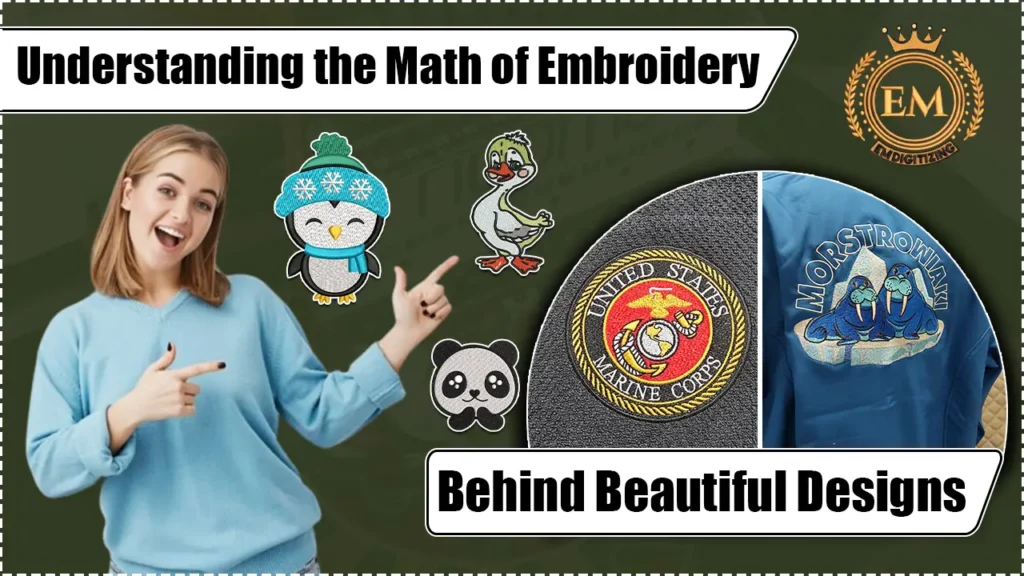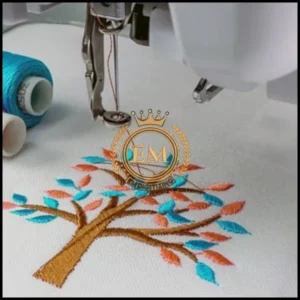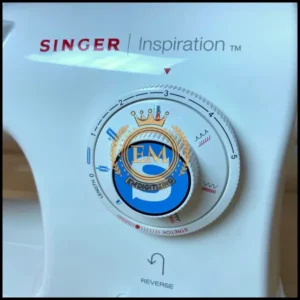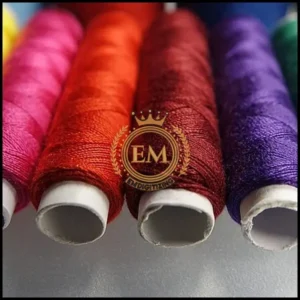El bordado es más que una hermosa forma de arte; También es una mezcla fascinante de creatividad y matemáticas.. Detrás de cada diseño complejo se encuentra un mundo oculto de principios matemáticos que guían el proceso de creación..
De las formas geométricas a la teoría del color, recuento de puntadas a algoritmos, Comprender las matemáticas del bordado puede elevar su trabajo a nuevos niveles de precisión y belleza..

En este articulo, Exploraremos las diversas formas en que las matemáticas se cruzan con el bordado., Descubrir los conceptos y técnicas clave que pueden ayudarle a desbloquear todo el potencial de su diseños de bordado.
Únase a nosotros en este viaje mientras desentrañamos las matemáticas detrás del cautivador mundo del bordado..
Comprender las matemáticas del bordado detrás de hermosos diseños
Introducción a las matemáticas del bordado.:
El bordado no se trata sólo de agujas, hilos, y tela; También implica una sorprendente cantidad de matemáticas..
Antes de que tus ojos se pongan vidriosos, no temáis!
We’;re here to break it down in a way that won’;No te hagas girar la cabeza.
Asi que, toma tu cinta métrica y tu calculadora, and let’;Sumérgete en el fascinante mundo donde los números y la costura se unen.
Por qué son importantes las matemáticas en el bordado?
Quizás te preguntes por qué son importantes las matemáticas en el bordado. Bien, piénsalo de esta manera: cada diseño de bordado es una representación visual de formas, patrones, y colores.
¿Y cuál es el lenguaje de los patrones y las formas??
Lo has adivinado: matemáticas!
Comprender las matemáticas detrás del bordado puede ayudarte a crear diseños más precisos, mejorar la calidad de la puntada, y asegúrese de que su pieza terminada luzca increíblemente profesional.
El papel de la geometría en los diseños de bordado:
La geometría puede traer recuerdos de la clase de matemáticas de la escuela secundaria, pero cuando se trata de bordado, it’;Es tu arma secreta para crear diseños impresionantes..
Let’;Exploremos cómo la geometría juega un papel vital en el mundo de la aguja y el hilo..
Formas geométricas básicas en bordado:
Triángulos, cuadrícula, círculos, oh Dios mío!
Estas simples formas geométricas son los componentes básicos de los diseños de bordado.. Descomponiendo diseños complejos en estas formas básicas, puedes coserlos fácilmente en tu tela.

Whether you’;volver a coser flores, animales, o incluso patrones abstractos, Comprender la geometría subyacente le ayuda a mantener la proporción y el equilibrio en su trabajo..
Incorporando simetría y equilibrio:
Nada llama más la atención que un diseño de bordado perfectamente simétrico.. La simetría aporta una sensación de armonía y equilibrio a tu trabajo., haciéndolo visualmente agradable.
Utilizando principios geométricos, Puedes asegurarte de que tus diseños tengan ese factor sorpresa simétrico..
De las imágenes reflejadas a la simetría radial, La geometría lo guiará en la creación de piezas de bordado llamativas, bien equilibradas y agradables a la vista..
Comprender el número y la densidad de puntadas:
El número y la densidad de puntadas pueden parecer términos técnicos propios de una fábrica., pero son aspectos cruciales del bordado que afectan la calidad y apariencia de tus diseños.
Let’;Desentrañamos esta matemática de los misterios del bordado y arrojamos algo de luz sobre su importancia..
Importancia del número de puntadas en el bordado:
El recuento de puntadas se refiere al "número de puntadas individuales utilizadas para crear un diseño de bordado".. Afecta el nivel de detalle y la apariencia general de su diseño..

Muy pocos puntos, y su diseño puede parecer escaso e inacabado. Demasiados puntos y podría volverse grueso y rígido.. Encontrar el equilibrio adecuado en el número de puntadas garantiza que su bordado luzca pulido y capture la esencia de su diseño..
Calcular la densidad de la puntada para obtener resultados óptimos:
Densidad de puntada va de la mano con el número de puntadas. Se refiere al espacio entre cada puntada y afecta la densidad o grosor del bordado..

Calcular la densidad de puntada implica considerar factores como Tipo de fábrica, espesor del hilo, y el efecto visual deseado. Encontrar la densidad de puntada óptima garantiza que su diseño de bordado luzca nítido, bien definido, y resiste la prueba del tiempo.
Explorando la teoría del color y la selección de hilos:
El bordado no se trata sólo de formas y puntadas; El color juega un papel vital a la hora de darle vida a tus diseños..
Let’;Examinemos cómo la teoría del color y selección de hilo de bordar puede mejorar tu juego de bordado.
El impacto del color en el bordado:
El color tiene el poder de evocar emociones., crear interés visual, y transmitir mensajes en tus bordados. Comprender la teoría del color, como complementario, análogo, o esquemas monocromáticos, puede ayudarle a seleccionar colores que armonicen y mejoren su diseño.
Ya sea que desee que su bordado sea vibrante y llamativo o sutil y sofisticado, Dominar la teoría del color te ayudará a lograr el impacto deseado..
Elegir los hilos adecuados para su diseño:
Con innumerables opciones de hilos disponibles, elegir los adecuados para su diseño de bordado puede resultar abrumador. Factores como peso del hilo, material, y la solidez del color entran en juego.

Teniendo en cuenta las características de los diferentes hilos de bordar y su compatibilidad con su tejido y diseño., Puede tomar decisiones informadas que darán como resultado bordados bellamente cosidos y duraderos..
Calcular la ubicación y el tamaño de los diseños de bordado:
Los cálculos juegan un papel importante en la colocación del diseño y tamaño.
Determinar la ubicación óptima en la tela:
Deciding where to place your embroidery design on a piece of fabric can be a bit like trying to solve a puzzle. ;
Pero no temas, las matemáticas pueden venir a tu rescate! ;
Usando las matemáticas del bordado, Puedes determinar la ubicación óptima para tu bordado en la tela.. Consider factors like the fabric’;dimensiones, el tamaño y la forma deseados del diseño, y cualquier otro elemento a incluir.
Con un toque de matemáticas, you’;Podrás encontrar el lugar perfecto para exhibir tu obra maestra del bordado..
Tamaño y escala de diseños de bordado:
Cuando se trata de bordado, el tamaño importa. Whether you’;estás trabajando en un parche pequeño o un tapiz grande, you need to consider the scaling of your design. ;
Here’;Es donde las matemáticas intervienen para simplificar tu vida.. Calculando las dimensiones deseadas y los factores de escala., puedes fácilmente cambiar el tamaño de su diseño de bordado para adaptarse a cualquier proyecto.
Asi que, don’;No permita que las limitaciones de tamaño limiten su estilo de bordado: deje que las matemáticas se encarguen de los números mientras usted se concentra en crear hermosas puntadas..
El futuro de las matemáticas en la digitalización de diseños de bordado:
El bordado no es ajeno a la tecnología, y los avances en la digitalización han revolucionado la industria. Con la ayuda de las matemáticas del bordado y software especializado., Los artistas ahora pueden convertir diseños complejos en archivos de bordado digitales with ease. ;
Este proceso de digitalización permite un control preciso sobre la colocación de las puntadas., cambios de color, and complex patterns. ;
Si encuentra alguna dificultad para digitalizar el bordado por su cuenta, le sugerimos que contrate a un experto.. Asi que, EMdigitalizing está ahí para ti. estamos ofreciendo digitalización de bordados and vector art services at the most affordable rates possible with fast delivery and high quality. ;
Puedes obtener 50% descuento en tu primer pedido. Asi que, ¿Qué estás esperando?, Aprovecha esta oferta y deja volar tu imaginación.!
Preguntas frecuentes:
El bordado a máquina automatiza la costura utilizando diseños digitales, Creación eficiente de patrones detallados en tela con máquinas especializadas..
Comenzar a bordar a máquina es bastante sencillo con las máquinas modernas., aunque dominar diseños complejos requiere práctica.
El recuento de puntadas indica el número total de puntadas necesarias para un diseño de bordado., afectando tanto el tiempo como el uso del hilo.
El tamaño de hilo comúnmente utilizado para el bordado a máquina es 40 peso, compatible con agujas estándar, y eficaz para la mayoría de los diseños.
